Articles and News
Translating The Trends To Make Yours A Destination Store | April 30, 2014 (0 comments)
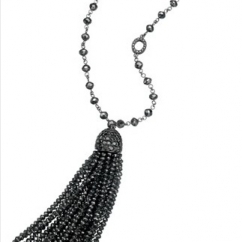
New York, NY—How can a luxury jeweler be sure they’re both on-trend and the best destination to buy those trends?
A special webinar hosted by the Plumb Club addressed those issues, along with a focus on the key jewelry trends in fashion right now and for the next few seasons. Panelists included renowned celebrity and style expert Michael O’Connor of Style and Substance, Helena Krodel of LuxeIntelligence, and Amanda Gizzi of Jewelers of America.
Michael O’Connor addressed the way trends develop.
“Trends evolve from fashion, economic, and social influences, and they occur at the intersection of all three,” he explained. Fashion influences, of course, include not only apparel runway shows but also movies and media. Economic influences impact how much consumers can afford to spend, and social influences are driven by consumers’ mindsets and what they consider to be appropriate at any given time or for any given set of individuals. Social influences, especially, are demographically driven, and the demographics driving it are skewed younger as Millennials take center stage away from maturing Boomers.
The most important current fashion influences include:
- Color on the runways, especially color blocking and mixes of colors that would previously not have been seen in American fashion
- International influences such as Ikat patterns and other Asian/Indian motifs; this also is a cross-trend evident in the abovementioned mixes of colors that previously were unfamiliar to Americans.
- Retro and vintage silhouettes, especially the Downton Abbey effect driving Twenties style touches like beading and dropped waists, and a revival of some Eighties looks like bigger shoulders. A further exploration of Eighties influence is driving larger proportions and bold trimmings, such as bold zippers, big ruffles, fringe, and so forth.
The way these influences are impacting jewelry include:
- Bigger, bolder proportions and more colorful pieces
- Exotic color combinations
- Mystical, spiritual, or tribal design themes
- Geometric themes
- Vintage jewelry
- Newer trends like hand jewelry are less popular but rising in trend centers on the coasts.
Turning to economic influences, O’Connor cited multiple sources predicting 2014 to be the strongest year since the recession. Rising job growth means consumers are expected to spend more, and rising global demand means U.S. manufacturers will benefit. All these will combine to help a consumerist mindset to return—albeit cautiously. (Editor’s note: Just-released job figures underscore O’Connor’s prediction.)
Apart from an ability to spend, how consumers spend is what will impact fine jewelry the most, says O’Connor. The “high-low” trend of combining things like Gap or H&M with designer bags and shoes shows no signs of abating; in fact, it’s still growing and it’s one of the things that’s helped blur the lines between fine and fashion jewelry. The recession also further blurred that, as jewelers sought to find pieces consumers could afford, and also changing perceptions of what’s fine and beautiful have led to an increased demand for both contemporary metals and nontraditional beauty, such as rough or included gems or weight-saving cuts like slices. Estate jewelry plays into this trend as well, giving consumers the vintage look they desire in fine jewelry at a price they can absorb.
Social shifts that are influencing the jewelry market include socially connected Millennials who are very individualistic. The generation that never knew what it meant not to personalize a cell phone demands the same kind of individuality in their jewelry. In a celebrity-obsessed culture where ordinary people can become celebrities just for doing their everyday routine (Jersey Shore and other reality shows), Millennials believe they’re the star and they also expect to be treated as a celebrity. The international influences O’Connor spoke about in fashion have a huge impact on the globally-aware Millennial generation, and, lastly, there has been a huge shift in gender roles for this generation, manifested in acceptance of same-sex relationships and less preconception of what is “male” and “female” adornment.
These trends have impacted fine jewelry in a number of important, measurable ways:
Significant interest in an eco-friendly, ethically mined, and traceable supply chain for metals and gems; customizable and personalized talismans, a huge influx of men’s jewelry, same-sex wedding jewelry and man-gagement rings.
“Same-sex couples will add $60 billion a year to the wedding industry,” says O’Connor. That’s a lot of couples of both genders looking for special jewelry and gifts for their weddings.
Helena Krodel of New York-based LuxeIntelligence hit on what she sees as the most important fine jewelry trends. Retailers need to not only be on top of these trends and aware of them, they need to be stocking them in the store and having them ready for customers now, she said. These include:
New earrings: ear cuffs and up-the-ear earrings, especially, are important. Also “ear brooches (big, brooch-style earrings), double-sided earrings, earrings with detail on the back, and mismatched earrings. The trend will translate from hip, urban areas where it started to more conservative small towns, says Krodel; it’s just in how it’s interpreted. Fashion-forward centers will wear huge ear cuffs, more conservative markets will have a petite line up the ear.
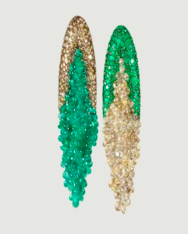
A gentle way to ease into the mis-matched earring trend is to choose a pair that reverse the colors but keep cohesiveness by using the same design. Photo courtesy Helena Krodel.
Rings are another important trend, but Krodel cautions it’s not so much what the ring itself looks like but how it’s worn. A ring that looks quite ordinary to any jeweler suddenly becomes trendy when it’s part of a stack or worn as a midi halfway up the finger. Or when it’s worn on the new finger-of-choice, the pinky. Double-finger rings and knuckle rings move away from their punk origins and toward the mainstream, as do two-piece rings connected by chains and hand jewelry.
The trend for stacking and layering moves off the hand and up the arm, with piles of bracelets—which Krodel points out that slim bangles are a great way for jewelers to sell up and turn a customer into a collector.
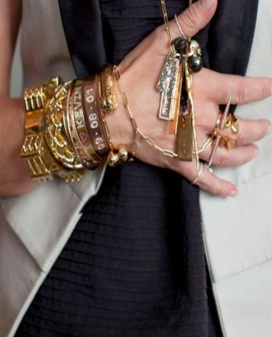
Piling on heaps of jewelry used to be considered tacky; today it's not only acceptable, but fashionable. Note the personal talisman effect of the date bracelet. Each piece in itself is not unusual but together the look is one of originality.
Color, of course, continues to be important. Pantone’s announcement of Radiant Orchid as the 2014 Color of the Year has sparked a rise in amethyst, rubellite, and rose quartz jewelry.
Other key vibes include punk influences like wings, crosses, and blackened metals, fringe and tassels, big chains evocative of the Eighties; and again, tribal flair. Even the open scrollwork design of a delicate cuff or earring may have its roots in tribal motifs, she says. (Black diamond tassel at top of page by Ivanka Trump Fine Jewelry.)
Finally, Amanda Gizzi of Jewelers of America offered a checklist of how jewelers can position their stores as the trend destination.
“Watch, read, invest, connect, promote, and refresh,” she said.
- Watch important trend-sparking events such as awards shows. For example, anything worn by Jennifer Lawrence, the current darling of Hollywood, is destined to impact trends, such as her “backlace” or her big emerald earrings.
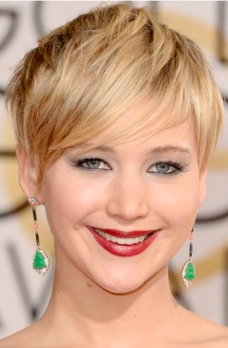
Jennifer Lawrence is the hot trend icon, driving demand for colorful drop earrings and pixie cuts.
- Read fashion magazines, websites, and blogs. All are equally influential in their own way, said Gizzi, with a gentle reminder that print is not dead, especially among young, unmarried women who are earning good money and don’t yet have a family to spend it on. Bloggers are increasingly influential and websites like Style.com are out with trends almost as soon as they happen.
- Invest in trend forecasting, such as publications or other services.
- Connect via social media to trend sources and in turn, to communicate the trends to your customers. Draw them into the conversation as well, asking for photos you can share of them wearing the trends.
- Promote yourself as the destination source for trends. Your website should reinforce trend information so it comes up higher in a search, said Gizzi. Don’t forget the traditional media like newspapers and TV, where your ads can focus on trends and you can pitch yourself as an expert on trends to be interviewed.
- Finally, refresh! Fine jewelry has an average turn of 1.1 times per year, so people don’t think to come in frequently to see what’s new. Change this by offering a lot of new throughout the year.
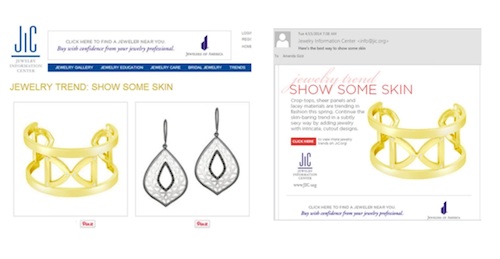
JIC's website reinforces trends. Image courtesy Amanda Gizzi and Jewelers of America.







